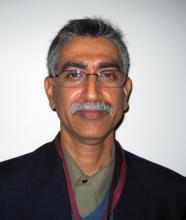VANCOUVER, B.C. – Although physicians might be reluctant to bring up smoking cessation with their patients for many reasons, it is one of the most important preventive activities they can undertake, according to Dr. Arunabh Talwar.
Smokers are ambivalent about smoking, he said at the annual meeting of the American College of Chest Physicians. On any given day, their smoking status hangs in balance between one set of factors favoring quitting and another set favoring continuing (BMJ 2007;335:37-41).
"All we need to do is just [tip the balance]," said Dr. Talwar, who is a pulmonologist at North Shore University Hospital in Manhasset, N.Y.
Indeed, if self-reports are reliable, about 70% of smokers want to stop and 30% try each year. But only 2%-3% succeed.
Referring to the multistage model of behavioral change, he noted that making smokers aware of the link between smoking and end-organ damage is critical in starting the process. "That is the most important thing that physicians do – they move patients from a precontemplation to a contemplation stage and set the stage for the smoking cessation process to occur."
There is compelling evidence of the benefits of smoking cessation, he said. It has been identified as the single most effective step for lengthening and improving patients’ lives (BMJ 2004;328:947-9).
"Make no mistake, smoking cessation activity is very cost effective," he added. "I think it is the most cost-effective primary prevention action that a physician can take."
Brief advice to quit costs $338 per year of life saved – or less than 5% of the cost per year of life saved from giving pravastatin for primary prevention of cardiovascular disease, aspirin for secondary prevention of coronary heart disease, or simvastatin for secondary prevention of myocardial infarction (BMJ 2004;328:397-9).
Still, physicians cite numerous barriers to promoting smoking cessation with their patients, according to Dr. Talwar (J. Smok. Cessat. 2008;3:92-100). A common one is being too busy.
"But studies show us, a minimal intervention – as [little] as 3 minutes of a physician’s time – can move patients from ‘precontemplation’ to contemplation, can help improve quit status," he said. Furthermore, "as you increase the intervention, the success rate will improve."
For example, just 0.3% of smokers succeed in quitting long term on their own, but the value rises to 1.6% when physicians simply ask their smoking status, 3.3% when they ask and provide advice on quitting, and 5.1% when they ask, advise, and give a pamphlet (BMJ 1979;2:231-5).
Busy physicians can streamline efforts by using a team approach. "Some of it can be shared by other health care providers, whether they are nurses, nurse practitioners, physician assistants," Dr. Talwar explained. "We use our respiratory therapists and [pulmonary function test] lab technicians as well; that way, the load gets divided. But also, repeated messages to the patient will help move them along."
Physicians should also consider using telephone "quitlines" (now freely available in all states) and patient support groups in the behavioral modification part of cessation, he advised.
Another barrier physicians cite, lack of expertise, has a stronger negative influence on their smoking cessation activities than lack of interest, time, or materials (Eur. J. Public Health 2005;15:140-5).
Indeed, in a survey of New York City–area health care providers, Dr. Talwar and his colleagues found that only 20% believed their training had adequately prepared them to treat tobacco dependence. And less than 10% were familiar with treatment guidelines. "We are a little bit behind in this, but medical schools have made a change, and most medical schools now make an effort to make sure that standard curricula [on smoking cessation] are there," he said. In addition, comprehensive information is readily available in the ACCP’s Tobacco Dependence Treatment ToolKit.
Reassuringly, physicians who receive training in this area are 1.5 to 2.5 times more likely to perform smoking cessation tasks (Cochrane Database Syst. Rev. 2000;CD000214).
Physicians also report a lack of financial incentives to be a barrier. Dr. Talwar noted that two CPT codes – 99406 and 99407 – specifically pertain to cessation activities during visits. Physicians can usually bill for this counseling, in addition to routine office visits, four times annually.
Half of physicians still believe that reimbursement is insufficient. "But the situation is much better than 7 or 8 years ago, when it was much more difficult to get reimbursement for these activities," he commented.
Physicians also mention patients’ low likelihood of quitting as a barrier to broaching smoking cessation, according to Dr. Talwar. But the irony is that quit rates are influenced in large part by physicians’ efforts and the intensity of those efforts.


